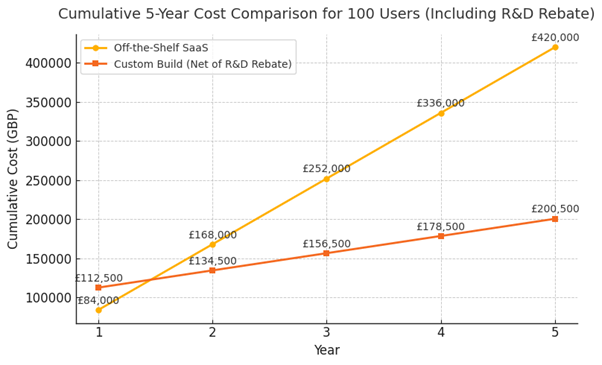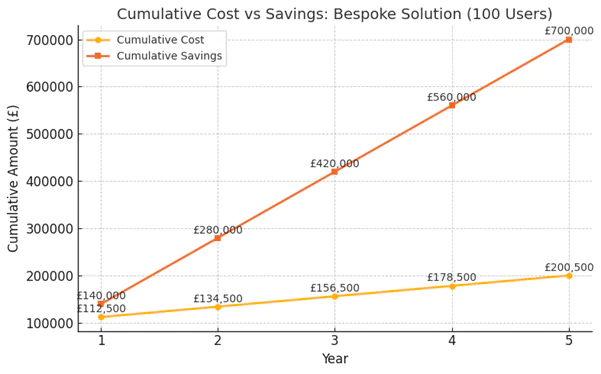This article compares OTS SaaS and custom-built bespoke case management software, exploring how each model impacts budget, long-term total cost of ownership and return on investment. It explains why a bespoke system, despite a higher initial outlay, can pay for itself over time through reduced subscription fees, tailored workflows and the creation of proprietary software assets.
This article covers:
- Cost components: licence or subscription fees, implementation charges, training and support costs
- Pricing models: per-user versus flat-rate and modular pricing for additional features
- Long-term savings: how bespoke solutions lower annual operating expense versus recurring SaaS fees
- Value creation: the strategic benefits of owning custom software, from intellectual property rights to competitive differentiation
Related Read: How Much does Software Development Cost?, What Is Bespoke Software?
TL;DR: Key Takeaway Points
Bespoke case management software demands a higher initial outlay but recoups its net cost within two years and delivers over 50 % savings over five years compared to off-the-shelf SaaS.
Key Takeaways
- Off-the-shelf SaaS case management software costs around £50–£100 per user per month, with no large upfront fees but higher ongoing licence charges.
- Bespoke development requires an initial investment (for example £150,000) net of a 25 % UK R&D tax rebate, then annual support of about £22,000, achieving payback by year two.
- Custom solutions deliver tailored workflows, full intellectual property ownership and lower long-term operating costs, making them more cost-effective over a five-year horizon.
How Much Does Case Management Software Cost

What Factors Influence the Cost of Case Management Software?
The cost of case management software is primarily shaped by deployment model, level of customisation, number of users, feature scope, integration complexity, support arrangements and regulatory compliance requirements.
The leading factors that drive pricing include:
- Deployment model: Off-the-shelf SaaS licences typically charge between £30 and £80 per user per month. Bespoke solutions replace subscription fees with a one-off development investment, encompassing hosting and infrastructure.
- Customisation and feature scope: Tailored modules, advanced workflows and unique features can add between £5,000 and £50,000 or more to the initial build.
- User count: SaaS costs scale linearly with seat licences, whereas bespoke platforms incur minimal extra expense per additional user once the core system is built.
- Integration and data migration: Connecting to existing case records, document management systems or third-party applications generally ranges from £4,000 to £20,000 depending on complexity.
- Support and maintenance: Bespoke solutions often reserve 15 to 20 per cent of the initial development cost each year for updates and technical support, while SaaS subscriptions typically include support within the licence fee.
- Compliance and security: Legal, regulatory or audit-trail requirements may incur extra costs for encryption, role-based access or reporting modules.
- Implementation and training: Onboarding for SaaS may cost £500 to £2,000 per user, whereas bespoke platforms usually bundle tailored training services into the overall project fee.
Here is a typical breakdown of development-related cost components for a bespoke case management system:
| Cost Component | Estimated Range (GBP) |
| Initial development | £12,000 to £96,000 |
| UI and user experience design | £8,000 to £32,000 |
| Backend development | £12,000 to £64,000 |
| Frontend development | £8,000 to £40,000 |
| Testing and quality assurance | £4,000 to £24,000 |
| Security and compliance features | £4,000 to £20,000 |
| Third-party integrations | £4,000 to £20,000 |
| Annual maintenance and updates | £4,000 to £16,000 |
| Marketing and launch | £4,000 to £24,000 |
| Total estimated cost | £56,000 to £336,000 |
This comparison shows why, although bespoke solutions require a higher initial investment, they often deliver lower ongoing operational expense and greater long-term value through owned intellectual property.
How Do Pricing Models for Case Management Software Work?
Pricing models for case management software include per-user subscriptions, tiered and modular plans, usage-based billing, perpetual licences and fixed-price or time-and-materials contracts for bespoke development.
Case management vendors offer a variety of pricing structures to suit different needs and budgets. Common models include:
- Per-user subscription
Vendors charge a monthly fee per user, typically ranging from £30 to £80 per user per month. Fully featured legal platforms often land around £50 per user per month. About 75 per cent of buyers budget between £45 and £90 per user per month. - Tiered plans
Basic, Professional and Enterprise tiers bundle increasing numbers of features. Entry tiers cover essential case-management tools, while higher tiers include client portals, advanced reporting and compliance modules. - Modular pricing
Add-on modules (such as time tracking, billing or analytics) are sold separately, from £10 to £30 per module per user per month. - Usage-based billing
Charges are based on actual usage metrics, for example £0.10–£0.50 per case processed or document stored. - Perpetual licence
A one-off licence fee from £20,000 to £100,000, with annual maintenance fees of 15 to 20 per cent of the licence cost. - Fixed-price bespoke development
Custom-built systems are commonly contracted at a fixed price of £50,000 to £200,000, covering requirements gathering, development and deployment. - Time-and-materials contracts
Development teams charge hourly rates (typically £80 to £150 per hour) so total cost varies with project scope and duration.
By selecting the most appropriate model, subscription for predictable budgets or bespoke contracts for tailored workflows; organisations can balance upfront costs against long-term value.
.

What Are the Typical Costs for SaaS vs. Custom Software Development?
SaaS platforms typically cost between £50 and £60 per user per month, while bespoke development demands a one-off investment of £25,000 to £200,000 or more, plus annual maintenance fees of around 15 to 20 per cent of that initial cost.
The key differences in cost structure include:
| Cost Aspect | Off-the-Shelf SaaS | Bespoke Software Development |
| Upfront investment | Minimal (usually setup fees only) | £25,000 to £200,000+ one-off development fee |
| Recurring charges | £50–£100 per user per month | 15–20 per cent of development cost per annum for support and updates |
| Licence model | Subscription | Perpetual licence bundled with a maintenance contract |
| Scalability impact on cost | Linear increase with user count | Negligible additional cost once core system is built |
| Intellectual property ownership | Provider retains IP | Client owns all software and IP |
| Typical break-even period | 6–12 months for mid-sized firms | 12–24 months depending on adoption rate and savings |
Organisations choosing SaaS benefit from predictable monthly expenses and minimal IT overhead, but they forgo ownership of the software and face rising subscription fees as they scale. Bespoke development demands a larger initial outlay but delivers tailored workflows, lower long-term operational cost and full intellectual property rights, often yielding a return on investment within two years.
Why Is Custom Software Development Often More Cost-Effective in the Long Term?
Custom software development can recoup its net investment in under two years once UK R&D tax relief is applied, thanks to low ongoing support fees and avoided subscription costs.
Organisations benefit from bespoke solutions through:
- Accelerated breakeven in around 1.5 years, assuming a £150,000 build cost reduced by a 25 per cent R&D tax rebate (£37,500), yielding a net first-year cost of £112,500. With £22,000 annual support, cumulative custom costs reach approximately £134,500 after two years, compared to £168,000 for SaaS licences at £70 per user per month.
- Elimination of perpetual subscription fees, saving £84,000 per year on average after year one.
- Ownership of intellectual property, creating a valuable asset that avoids vendor lock-in and can be extended or repurposed.
- Lower annual maintenance charges, typically capped at 15–20 per cent of development cost (approximately £22,000 per annum in this example), versus full licence renewal fees for SaaS.
- Productivity gains of around 15 per cent, driven by workflows tailored to exact business processes and targeted automation that reduces manual case handling time and speeds up throughput.

As shown in the cumulative five-year cost comparison, the custom build’s higher upfront investment; net of R&D rebate, is offset by much lower operating expenses. Beyond year two, bespoke development delivers significant net savings, making it the more cost-effective choice over the software lifecycle.


Discuss Your Project Today
How Can You Minimise Ongoing Software Maintenance and Support Expenses?
Effective strategies such as automated testing, containerisation, predictive maintenance and modular support agreements can reduce annual maintenance costs by up to 40 per cent and cap support fees at around 15 per cent of development cost.
Custom software development teams can control and reduce support expenses by adopting proactive practices and modern tooling:
| Strategy | Typical Cost Saving |
| Automated testing | 15 per cent reduction in operational cost and 20 per cent improvement in software quality |
| Containerisation and DevOps | 50 to 60 per cent infrastructure cost savings for large deployments |
| Predictive maintenance | 10 to 40 per cent lower maintenance expenditure versus reactive approaches |
| Modular support agreements | Caps annual fees at 15–20 per cent of initial development cost, instead of full licence value |
| Outsourced managed services | Typically 20–25 per cent cheaper than in-house support teams |
Key tactics include:
- Implementing continuous integration and automated test suites to detect defects early and reduce manual testing hours by over 30 per cent.
- Migrating components into containers and orchestrating with Kubernetes to optimise resource usage and streamline upgrades.
- Scheduling regular health checks and applying predictive analytics to anticipate issues before they impact users.
- Negotiating tiered support contracts that separate routine updates from critical bug fixes, ensuring predictable budgets.
By combining these approaches, organisations can lower annual maintenance outlay from a typical 60 per cent of lifecycle cost down to as little as 15 per cent, while maintaining software reliability and accelerating feature delivery.
Do Hidden Fees Impact the Total Cost of Case Management Software?
Yes. Hidden fees; such as training, data migration, integrations and licence under-utilisation, typically add 10–25 per cent to initial and ongoing costs, surprising many buyers with unbudgeted expenses.
Hidden charges can erode projected savings and complicate budgeting. Common unexpected costs include:
- Training and onboarding: Vendors may charge £500–£2,000 per user for bespoke training sessions, adding 10–15 per cent on top of licence or development fees.
- Data migration and integration: Transferring legacy records and connecting third-party systems can cost £4,000–£20,000, depending on complexity.
- Unused or under-utilised licences: Studies show firms waste around 15–20 per cent of SaaS seat budgets on dormant accounts.
- API access and add-ons: Access to advanced modules or developer APIs may carry extra fees of £10–£30 per user per month.
- Contract escalations and renewals: Auto-renew clauses or annual price hikes of 5–10 per cent can inflate OPEX unexpectedly.
- Post-go-live customisations: Change requests outside the original scope often attract time-and-materials rates of £80–£150 per hour.
Off-the-shelf SaaS solutions may conceal such costs within “implementation” or “premium support” tiers, while bespoke contracts can mitigate surprises by defining fixed-price deliverables. To avoid hidden fees, organisations should:
- Conduct a comprehensive RFP with itemised cost breakdowns.
- Negotiate clear scope and cap on change-request charges.
- Audit current licence usage quarterly.
- Include contingency allowances of 10–15 per cent in budgets.
By accounting for these factors up front, businesses can achieve more accurate total cost of ownership and avoid unwelcome cost overruns.utcomes, ensuring PoC budgets stay lean while insights stay robust; a balance that inexperienced teams rarely achieve.

Need Expert Guidance?
We provide fully managed end-to-end solutions for operators and service companies needing expert guidance.
Take advantage of our unique {SD:UK} CTO as a Service solution. Our experts help you to formally capture requirements, create a system specification and then fully manage the implementation of your project for a successfull delivery.


How Can ROI Be Measured for Case Management Software Investments?
ROI measures how much money a company saves compared to what it spends, showing that bespoke case management software often pays for itself in the first two years.
To calculate ROI:
- Sum the net cost each year (initial build minus R&D rebate, plus support fees)
- Estimate annual savings from faster workflows and fewer errors
- Compare cumulative savings against cumulative costs
A simple example for 100 users:
– Year 1 net cost: £150,000 − £37,500 rebate = £112,500
– Years 2–5 support: £22,000 each year
– Annual savings: £140,000

Key steps:
- Calculate net build cost after UK R&D relief in year 1
- Add annual support fees in subsequent years
- Estimate savings from productivity gains
- Track cumulative totals
Below is a chart showing cumulative cost versus cumulative savings over five years. The point where the savings line rises above the cost line indicates the break-even, which occurs soon after year 1. This straightforward approach helps decision-makers see exactly when their bespoke software investment begins to deliver pure savings.
Conclusion
Bespoke case management software often delivers the greatest long-term value, recouping its net development cost (including UK R&D tax relief) within two years and generating substantial annual savings thereafter. Over a five-year horizon, bespoke solutions have the potential to deliver more than 50 % total cost savings compared to off-the-shelf SaaS licences.
Organisations should:
- Carefully compare total cost of ownership for SaaS licences against custom build expenses
- Leverage R&D tax incentives to reduce initial outlay
- Negotiate fixed-price development milestones and clear support agreements
- Track ROI through simple cumulative cost versus savings analyses
With tailored workflows, full intellectual property ownership and lower ongoing support fees, bespoke solutions offer faster payback and stronger efficiency gains than off-the-shelf alternatives. For businesses seeking award-winning case management platforms, Software Development UK has designed and delivered market-leading bespoke systems that combine industry-best security, compliance modules and user-centric design. Their proven track record demonstrates rapid return on investment, seamless integrations and bespoke training that maximises user adoption.
By following these expert recommendations, decision-makers can select the right deployment model, control budgets effectively and ensure their case management software becomes a strategic asset rather than just another expense.
Further Reading:
Here are five essential books on estimating, budgeting and measuring ROI for bespoke versus off-the-shelf software projects:
Software Estimation: Demystifying the Black Art
Steve McConnell
Microsoft Press, 2006.
Estimating Software Costs: Bringing Realism to Estimating
Capers Jones
McGraw-Hill, 2007 (2nd edition).
Maximizing ROI on Software Development
Vijay Sikka
Auerbach Publications (Taylor & Francis), 2004.
Software Sizing, Estimation, and Risk Management: When Performance is Measured Performance Improves
Daniel D. Galorath & Michael W. Evans
CRC Press/Auerbach Publications, 2006.
ROI of Software Process Improvement: Metrics for Project Managers and Software Engineers
David F. Rico
J. Ross Publishing, 2004.
Frequently Asked Questions
Provided below is an FAQ to help you understand our services in more detail. If your question is not covered please feel free contact us.
Most SaaS platforms charge between £50 and £70 per user per month, covering hosting, updates and basic support.
Custom builds generally require an initial investment of £100,000 to £200,000, depending on feature scope and integrations.
After applying a 25 % UK R&D tax rebate, bespoke solutions usually recoup their net cost within 18–24 months
Yes. Profitable firms can reclaim 25 % and loss-making firms up to 33 % of qualifying software R&D spend in the first year.
Annual support and maintenance typically run at 15–20 % of the initial development cost (around £22,000 per year in our example).
Training, data migration, extra modules and licence under-utilisation can add 10–25 % to the advertised subscription cost.
ROI = (Cumulative Savings − Cumulative Costs) ÷ Cumulative Costs. Bespoke solutions often exceed 100 % ROI by year 2.
Small teams may prefer predictable SaaS subscription fees, while larger firms benefit more from bespoke builds’ lower OPEX and full IP ownership.

